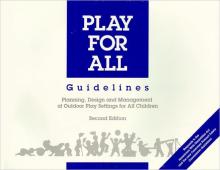
Play for All Guidelines: Planning, Design and Management of Outdoor Play Settings for All Children was edited by Robin C. Moore, Susan M. Goltsman, and Daniel S. Iacofano. The book was originally published in 1987, with the second edition published in 1992. The editors are partners in the planning and design firm of Moore Iacofano Goltsman, Inc., with many years’ experience in the field of children’s environments. There were many other contributors who helped develop the guidelines found in the book.
Play for All Guidelines is an industry standard for planners, designers, and managers of outdoor play settings. It is a comprehensive design resource available for integrating children of all abilities in the same play area. It addresses the full range of play-related issues: safety and risk management, accessibility and integration, maintenance, and child development. The revised edition reflects the requirements of the Americans with Disabilities Act and the U.S. Consumer Product Safety Commission's guidelines for public play areas.
“The Guidelines are based on six principal assumptions:
- All children have a right to play. Play is a process by which children learn. Good quality play opportunities have a significant impact on child development.
- The type, quality, and diversity of children’s physical settings (play value) directly affect the type, quality, and diversity of children’s play.
- The type, quality, and diversity of the social setting (play leadership and programming) directly affects play value. Play leadership (or animation, as it is sometimes called) refers to the critical role of trained staff, or play leaders, engaging children in creative interaction with each other and their surroundings.
- Children with physical, mental, emotional and social disabilities have an equal right to play opportunities.
- Integration of children with different abilities is based on the concept of accessibility which relates to both the physical and social environments (e.g., the attitudes and awareness of staff towards children with disabilities will greatly affect the rate and depth of integration).
- The quality of settings and their play value are severely threatened by liability costs and the threat of suit. Risk management strategies and management policies should be developed to protect the quality and value of children’s settings.”1
The book is divided into four parts: Site Planning and Design, Setting Design and Management, PFA Guidelines in Action, and Programming and Management.
“Part A: Site Planning and Design” contains three chapters: Child Development Objectives, Site Analysis, and Site Design Criteria. A well-designed play environment should provide children with developmental opportunities for motor skill development; for decision making; for learning; for dramatic play; for social development; and playing should be fun. Site analysis requires looking at the external aspects of the site, such as the location, access, and visibility as well as the internal aspects of size, shape, and configuration. Every site is unique and should be analyzed for its appropriateness at the same time that the design program is being prepared. There are five key design criteria for a good play environment: accessibility; safe challenge; diversity and clarity; graduated challenge; and flexibility. The book includes 29 other design criteria that may be equally important depending on each circumstance.
“Part B: Setting Design and Management” describes in Chapter 4 eight criteria for managing play settings: play value; programming potential; play leadership; safety; risk management; accessibility; integration; and management. Chapters 5-21 discuss the detailed requirements of seventeen types of play settings reflecting the importance of choice and diversity in the child’s environment. The seventeen settings are: entrances; pathways; signage; fences/enclosures; manufactured play equipment settings; multipurpose game settings; ground covers/surfacing; landforms/topography; trees/vegetation; garden settings; animal settings; water settings; sand settings; play props and manipulative settings; stage settings; gathering, meeting and working places; and storage settings.
“Part C: PFA Guidelines in Action” describes a project the editors were involved in to rebuild a public playground at Flood Park in San Mateo County, California, that used the book’s Play for All Guidelines in the design process. Chapter 22 describes the design process and includes detailed site drawings that show the play elements included in the various settings in the park. A plan checklist is also included that was used as a decision-making tool to weigh the trade-offs required for each setting before moving into the design development phase.
“Part D: Programming and Management” offers in Chapter 23 an overview of play programming for integration of all children. The suggestions were based on these conclusions:
- The greater the range of outdoor settings the wider the assortment of programmed activities that can be supported.
- A broad range of activities allows more children of different ages and ability levels to participate at the same time.
- A programmatic base in the community arts, instead of sports, offers many opportunities for participation by all children.
- A thematic approach to workshop activities, in combination with skilled play leadership, provides a structure which allows children to work together through dramatic play. It also helps adults relate positively to the program and to better understand its value.
- The “play value” of play settings is highly dependent on how they are programmed and managed, especially for the integration of children with and without disabilities.2
Chapter 24 contains risk management strategies for children’s play environments and programs. This final chapter gives guidelines for key strategies including reporting incidents, incident data analysis, supervision, first aid preparedness, training, community involvement, communication, and others.

